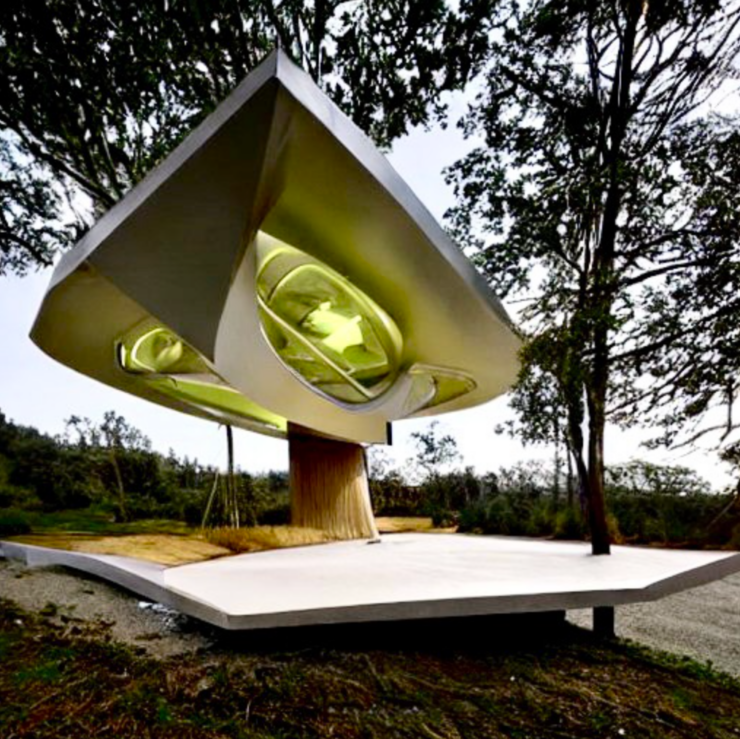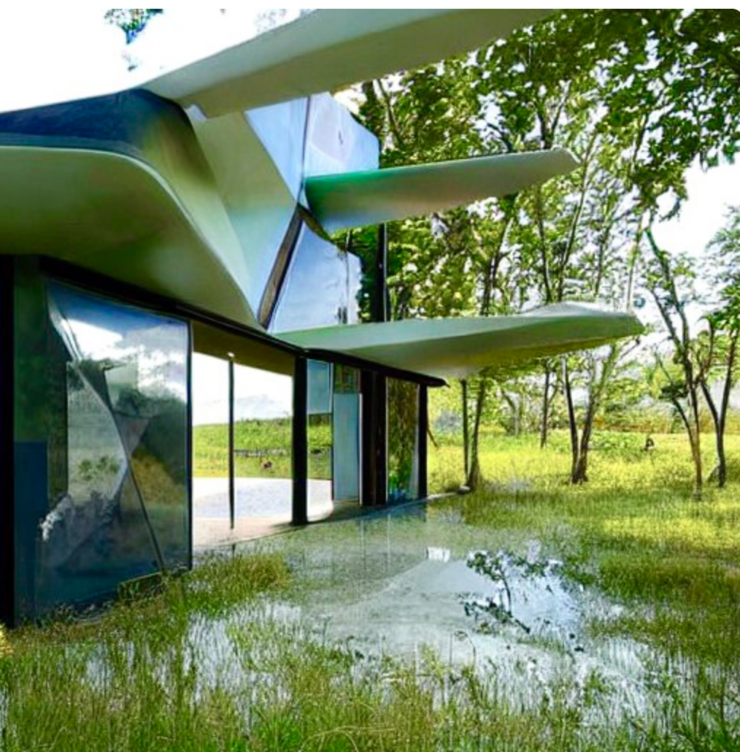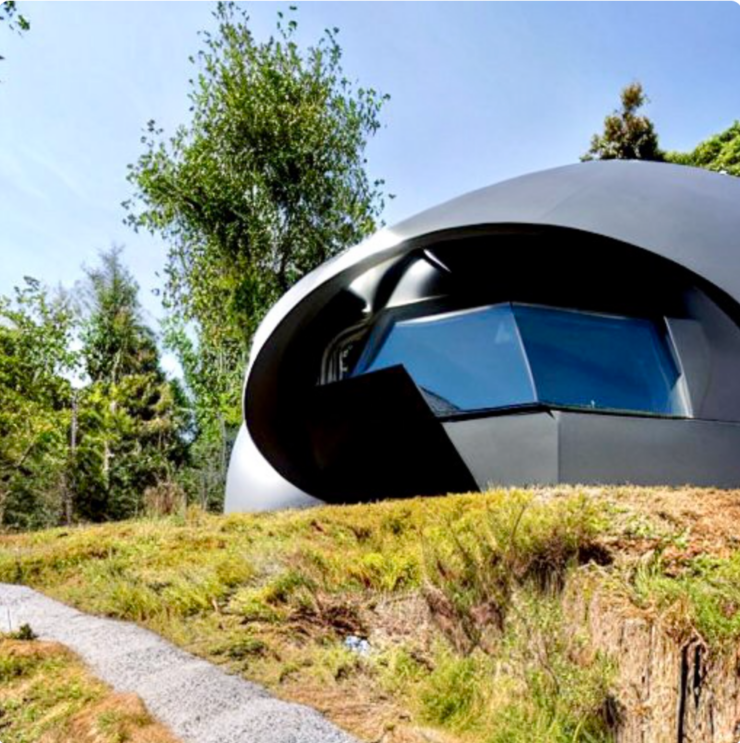[urban interfaces] Blogs
Guest blogpost: Olga Efremov – Het Hoge Bos Revisited: Speculative Zoöprototyping with Generative AI
For our [urban interfaces] seminar series on the theme Creative Urban Methods (year 2022-2023), we invited participants to write blogposts. The best and most interesting ones we publish on our website.
Below is the blogpost for seminar session #1, written by Olga Efremov.
Olga is a student of Media, Art and Performance Studies RMA programme specialising in digital cultures, new and emergent media, media technology, and digital art and performances in urban context. She also an independently published speculative fiction author exploring the possibilities of speculative fabulation for shaping future urban spaces and technologies.
————————–
Het Hoge Bos Revisited: Speculative Zoöprototyping with Generative AI
by Olga Efremov
“2024: Miiki Tiinnenenn’s eco-housing project was commissioned for De Uithof residential area, part of Utrecht University campus. Miiki won his first design award for this project, at age twenty-three. ‘I’m not building a home – I’m building a dream, a vision. A future.’
No point in dwelling on it too much.”
Readers coming across this short passage twelve months from today will no longer be jarred by past tense; they may in fact, just like the story’s narrator see no point in dwelling too much on yet another Utrecht Science Park project: the campus is growing and it is no secret that sustainability plays a key role in the development plans. They may never question the actual existence of talented Miiki Tiinnenenn, or the eco-house that he had designed: the future envisioned by an imaginary architect from a speculative fiction novel already feels real enough. If anything, this demonstrates the power of speculative fabulation, a term coined by Donna Haraway (2016). Written as a part of MA in Creative Writing research, Het Hoge Bos ecological compound was conceived as an illustration of the utopian concept of “Eco-Earth” where climate and energy crises have been resolved through technological advances and coordinated social change. This speculative urban setting seemed a highly suitable artefact to explore fiction writing as a creative urban method in response to Klaas Kuitenbrouwer’s ongoing work on Zoöp Project. Kuitenbrouwer is a researcher at Het Nieuwe Instituut who is leading the initiative for establishing a new form of organizational model, a Zoöp that would allow any organization to take a more responsive and responsible position towards the issues of ecological regeneration within their sphere of influence. The project team envision the Zoönomic Institute as a licensing body that promotes the adoption of the organizational governance model based on a Zoönomic Year Cycle, a four-step model for developing the situated zoönomy: an economic model that considers the interests of non-human community.
The first and second stages of the Zoöp cycle, “demarcating” and “observing” are the ones that in my opinion could benefit the most from the creative urban methods as a part of the methodological framework for a Zoönomic Foundation, an entity within the organization’s board which “acts as the speculative and political organs to non-human community” (2021). The organization that indicated their interest in getting a full Zoöp accreditation can use its “proto-Zoöp” status to establish a speculative imaginary that employs creative urban futuring methods both for demarcating the scope and territory of their Zoöp as well as for observing and sensing the network of relations between different human and non-human bodies within that territory. Such an imaginary would not only highlight existing problematics of the Zoöp but also allow the space for the critical making of longer-term vision scenarios and prototypes, similar to the ones I explored in my speculative fiction project. What if Het Hoge Bos is to become a Zoöp, a housing community for the families of Utrecht University scholars who practice a more-than-human way of living as an embodied research method? In my imagination, growing up in Het Hoge Bos is in many ways similar to the experience of Truus Schroeder’s family: it shapes the way the children relate to the world around them. But how can I bring others to the world of my imagination to make them see and experience the house and its surroundings in the same way?

Panu Lehtovuary (2023) a researcher from Tampere University School of Architecture, suggests “engaging (with) images” as a method for developing place-based future stories (74). Lehtovuary suggests using images that are in the public domain to create “a playful canvas of ideas” (75). I have tried to expand this method by asking an OpenAI image generator to produce a set of pictures based on a text prompt “futuristic ecological house” (Figure 1), and then selecting the pair of images that in my opinion best represented the type of dwelling my character’s family could live in (Figures 2 and 3). For me as a creative writer, these two AI-generated images are sufficient to close the imagination gap: I can write the character into this setting that would act as a visual writing prop and add sensory memories I got from visiting the location. Integrating open-source AI-generated images into creative writing workflow turns out to be a matter of mastering yet another user-friendly digital tool. The process involved in the selection of the final two images, however, required knowing the backstory of the characters and the worldbuilding setup, hence making it an idiosyncratic task that no AI engine is capable of performing.

Figure 2.

Figure 3.
The collective narrating of a Zoöp speculative story with the help of both location-sourced and AI-generated visual material can be a productive exercise for both articulating the boundaries of the Zoöp and brainstorming the list of possible interventions to be implemented during the later stages of the zoönomic year cycle. It is especially useful considering the pragmatic task of sourcing 50-100 copyright-free images, as Lehtovuary’s method recommends (74). Rather than fully delegating the task of “making a Zoöp” to AI, the method would build on the organizational knowledge and practices that are necessary to contextualize the selected visuals and integrate them into the project’s documentation and discussions (76). In my story I envisioned a kind of unresolved mystery surrounding Het Hoge Bos compound that the novel’s young protagonist was set to uncover. The unfinished trilogy never got to this point, but the session with Klaas Kuitenbrouwer got me thinking: what if it could be turned into a participatory speculative theatre XR experience and possibly as a model for a proto-Zoöp where it is up to the participants to solve the mystery? What kind of discoveries and critical insights can such a project lead to? What curatorial ecologies would be necessary for the speculative Het Hoge Bos Zoöp project to come into being? Last but not least, could zoöprototyping be a suitable neologism for a method of speculative critical making based on zoönomic ethos and Zoöp’s organizational practices?
I think this is the beginning of a beautiful zoöperation.
References
Haraway, Donna. 2016. Staying with the Trouble: Making Kin in the Chthulucene. Duke University Press.
Lehtovuori, Panu. 2023. “Engaging (With) Images: Place-Based Future Stories.” In Repository: 49 Methods and Assignments for Writing Urban Places, edited by Carlos Machado e Moura, Dalia Milián Bernal, Esteban Restrepo Restrepo, Klaske Havik, and Larin Nikulae, 74–77. Rotterdam: nai010publishers.
Nieuwe Instituut. 2021. “Klaas Kuitenbrouwer on Demarcating.” Vimeo. October 15, 2021. https://vimeo.com/632747172.
Images:
Efremov, Olga. 2023. Uithof 2222. AI-generated image collection. Moerdyke Creative Writing [MCW] Lab. https://moerdyke.livejournal.com/413608.html.

